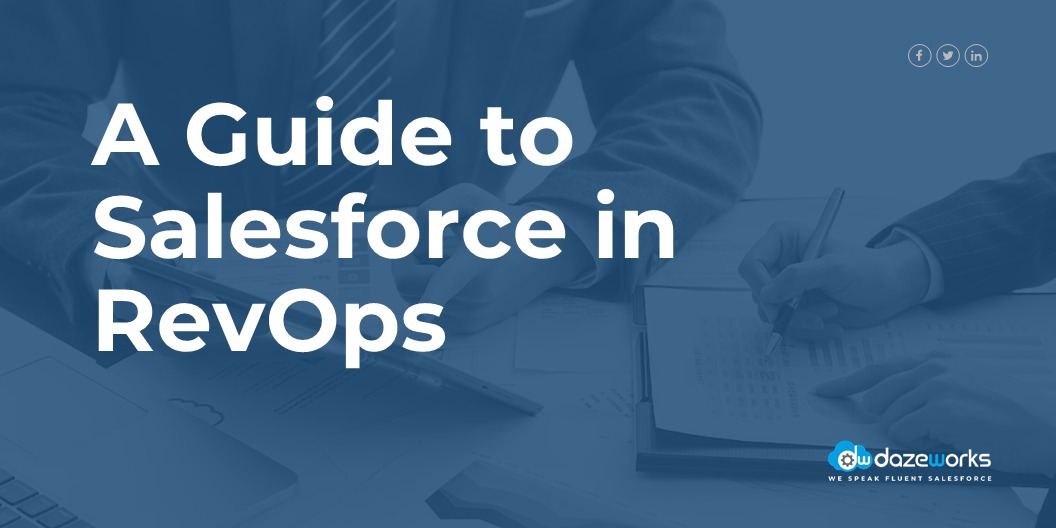
A Guide to Salesforce in RevOps
minutes read
In today’s rapidly evolving business landscape, companies constantly seek innovative strategies to drive revenue growth and improve overall business performance. One approach that has gained significant traction in recent years is Revenue Operations, also known as RevOps. RevOps is a holistic approach that aligns sales, marketing, customer success, and finance functions to optimize revenue generation. This comprehensive guide will provide a detailed understanding of RevOps and how it can be effectively implemented within the Salesforce ecosystem.

What is Revenue Operations?
Revenue Operations is a strategic framework that brings together various departments, including sales, marketing, customer service, and finance, to streamline and optimize the entire revenue generation process. Unlike traditional siloed approaches, RevOps aims to break down departmental barriers and promote collaboration, leading to increased revenue and improved customer satisfaction.
At its core, RevOps focuses on aligning people, processes, and technology to enhance the sales cycle, improve operational efficiency, and drive revenue growth. It involves leveraging data-driven insights, implementing standardized processes, and utilizing innovative technologies to create a seamless revenue generation ecosystem.
The Role of Salesforce in Revenue Operations
Centralized Data Management
One of the fundamental components of Revenue Operations is centralized data management. Salesforce serves as a single source of truth, enabling businesses to consolidate customer data, interactions, and transactions in one platform. This centralized view provides a holistic understanding of the customer journey, enabling more accurate forecasting, better decision-making, and improved customer experiences.
Seamless Integration with Third-Party Systems
Salesforce allows for seamless integration with various third-party systems, including marketing automation platforms, finance systems, and customer support tools. This integration ensures that data flows seamlessly between different departments, enabling a unified and cohesive revenue generation process.
Automation and Workflow Optimization
Salesforce’s automation capabilities empower businesses to automate repetitive tasks, streamline workflows, and reduce manual effort. This automation not only enhances operational efficiency, but also enables teams to focus on high-value activities such as lead nurturing, sales strategy, and customer success.
Advanced Reporting and Analytics
Salesforce provides robust reporting and analytics capabilities that enable businesses to gain valuable insights into their revenue operations. With customizable dashboards, real-time analytics, and AI-driven insights, companies can track Key Performance Indicators (KPIs), measure revenue performance, and identify areas for improvement.
Implementing Revenue Operations in Salesforce
Define Revenue Operations Goals and Objectives
The first step in implementing Revenue Operations is to define clear goals and objectives. Identify the key revenue drivers, define measurable KPIs, and align them with the overall business strategy. This will provide a framework for measuring success and tracking progress.
Assess Current Processes and Identify Gaps
Conduct a thorough assessment of the existing sales, marketing, customer success, and finance processes. Identify gaps, inefficiencies, and areas for improvement. This analysis will help prioritize the implementation of Revenue Operations initiatives and highlight the areas that require immediate attention.
Establish Cross-Functional Collaboration
Promote cross-functional collaboration by fostering open communication, establishing shared goals, and encouraging collaboration between different departments. This collaborative approach will facilitate the alignment of processes, data, and technology, enabling a seamless revenue generation process.
Implement Standardized Processes
Standardize processes across departments to ensure consistency and efficiency. Define clear workflows, establish best practices, and implement standardized tools and technologies. This will enable teams to work cohesively towards common goals, reducing miscommunications and streamlining the revenue generation process.
Leverage Data and Analytics
Leverage Salesforce’s robust data and analytics capabilities to gain actionable insights into customer behavior, revenue trends, and performance metrics. Use these insights to drive data-driven decision-making, identify areas for optimization, and uncover new growth opportunities.
Automate Repetitive Tasks
Leverage Salesforce’s automation capabilities to automate repetitive tasks and streamline workflows. This automation will free up valuable time for teams to focus on high-value activities such as strategic planning, customer engagement, and revenue optimization.
Continuously Monitor and Improve
Implement a culture of continuous improvement by regularly monitoring key metrics, analyzing performance data, and seeking feedback from stakeholders. Identify areas for improvement, implement necessary changes, and iterate on processes to ensure ongoing revenue optimization.
Key Metrics for Revenue Operations Success
Revenue Growth
Track overall revenue growth to assess the effectiveness of Revenue Operations initiatives. This metric provides a high-level view of the impact of RevOps on the company’s financial performance.
Customer Acquisition Cost (CAC)
Measure the cost of acquiring new customers to evaluate the efficiency of marketing and sales efforts. Lower CAC indicates more cost-effective and efficient customer acquisition strategies.
Customer Lifetime Value (CLTV)
Calculate the CLTV to assess the long-term value of each customer. This metric helps prioritize customer retention and expansion strategies, ensuring sustainable revenue growth.
Sales Velocity
Sales velocity measures the speed at which deals move through the sales pipeline. It helps identify bottlenecks in the sales process and highlights areas for improvement to accelerate revenue generation.
Win Rate
Track the percentage of deals won versus the total number of opportunities. A higher win rate indicates more effective sales strategies and better conversion rates.
Churn Rate
Monitor the rate at which customers churn or discontinue their relationship with the company. Lower churn rates signify higher customer satisfaction and retention.
Customer Satisfaction (CSAT)
Measure customer satisfaction through surveys, feedback, and customer support interactions. Higher CSAT scores indicate better customer experiences, leading to increased loyalty and repeat business.
Conclusion
Revenue Operations is a strategic approach that aligns sales, marketing, customer success, and finance functions to optimize revenue generation. With Salesforce’s comprehensive suite of tools and capabilities, businesses can effectively implement Revenue Operations and achieve sustainable success in today’s competitive business landscape.
